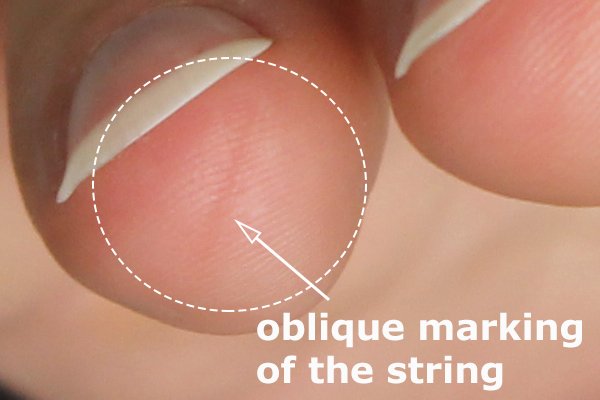
Tárrega Francisco, "Recuerdos de la Alhambra" (Partitura y TAB)
Version y Digitación: Renato Bellucci

Recuerdos de la Alhambra es la pieza que todo estudioso y amante de la guitarra clásica quiere tocar para sentir que su carrera ha llegado a un punto importante. "Recuerdos de la Alhambra” es un gran logro personal para cualquier guitarrista porque es sin duda alguna, el trémolo más difícil porque el trémolo transcurra mayormente en la segunda cuerda.
Francisco Tárrega es "el primer gran compositor para guitarra". Era español y conocía a fondo el instrumento. Sus habilidades como compositor y virtuoso de la guitarra, fueron perfectas, especialmente en vista al mundo que Andrés Segovia propondría pocos años después al que se denomina comunmente como “el mundo de la guitarra moderna”. A diferencia de Sor, Giuliani y Carcassi, las piezas de Tárrega fueron "la combinación perfecta entre la guitarra moderna y el alma de España".
Recuerdos de la Alhambra es un trémolo. Trémolo, es una técnica musical heredada del mandolín. A medida que el intérprete toca el trémolo con los dedos a, m e i, el pulgar (p) dibuja una bellísima y nostálgica melodía en forma de un contrapunto en las bordonas (los bajos).
No aprendes el trémolo primero y luego tocas Recuerdos de la Alhambra. Aprendes el trémolo a medida que aprendes Recuerdos. de la Alhambra.
Ejecuta la secuencia del trémolo pensando en 3 notas consecutivas pulsadas con los dedos a-m-i. No fuerces nunca la velocidad en el trémolo porque se supone que la velocidad sucederá de forma natural. Practica el trémolo utilizando un metrónomo, posiblemente uno mecánico. Amedida que aprendes la pieza, acentúa ligeramente la segunda nota del trémolo -dedo m-. Esto ayudará a nivelar el sonido general cuando aumentes la velocidad.
Siente la cuerda con cada pulsación de los dedos de la mano derecha plantando el dedo con precisión porque, dependiendo de cuán preciso seas al plantar los dedos, y de modo muy especial el dedo a, tu trémolo será más o menos fluido y bello.
Para lograr la fluidez en la mano izquierda en Recuerdos de la Alhambra, trabajé varias digitaciones a lo largo de los años. La que brindo a continuación, es la mejor que se me ha ocurrido hasta la fecha. Claramente, hay lugar para mejorías y, de hecho, estás invitado a proponer alternativas.

anything. "Recuerdos is a major achievement for the guitar player".
Francisco
Tárrega is "the first real guitar composer". He was a Spaniard and he
knew the guitar thoroughly. His composition skills were simply perfect
for the modern guitar. Unlike Sor and Giuliani, Tarrega's pieces were "the perfect match between the modern guitar and the soul of Spain."
Recuerdos de la Alhambra is a tremolo piece. Tremolo is a musical idea that comes from the mandolin family of instruments. As the player plays the tremolo with the a, m and i fingers, the thumb plays a nostalgic melody in a contrapuntal style.
You do not learn tremolo first and then you play Recuerdos. You learn tremolo as you learn Recuerdos.
Play the tremolo sequence as 3 consecutive notes. Do not force speed on the tremolo because speed is supposed to come naturally with tremolo after a few days. As you are learning the piece, put a little accent on the second note of the tremolo. This will help even out the overall sound by the time you pick up speed.
Feel the string with every strike of the right hand fingers and plant the a finger precisely because, depending on how precise you are with the a finger, your tremolo will be more or less fluid.
In order to achieve fluidity in Recuerdos de la Alhambra, I worked on several fingering possibilities. The one I publish below is the best I have come up with to this date.
Atención
El error más común en el estudio del trémolo, es que muchos de los estudiantes quieren empezar tocándolo a la velocidad final. Recuerda que el trémolo es una técnica muy compleja y al mismo tiempo, necesita de mucha relajación. Solo aquellos guitarristas que estudian el trémolo de la forma correcta, tocarán un trémolo hermoso. Debes hacerte amigo del metrónomo, y , si no lo es aún, es mejor que consideres convertirlo en uno con urgencia. Recomiendo los metrónomos de tipo pendular porque entrenan la vista al igual que el oído y esto, te será muy útil cuando toques con otros músicos. Comienza con el metrónomo en 80 golpes por minuto y aumente gradualmente. Solo aumenta la velocidad cuando puedas tocar sin errores durante 30 segundos. Sin excepciones!
Sentir la cuerda
Lo que muestra la foto de arriba, es el surco que queda marcado en la punta del dedo que pulsa cuando plantas el dedo en la segunda cuerda haciendo fuerza. La carne en la punta de un dedo está tocando la cuerda y está actuando como un sensor. Al forzar a la mano derecha a plantarse en la cuerda, le estás enseñando a la mano cómo permanecer muy cerca de las cuerdas en todo momento y le enseñas al dedo de la mano derecha a sentir la cuerda antes de pulsarla. Tocar y sentir la a cuerda, te da control sobre el sonido exacto que deseas producir y evita que te equivoques de cuerda. Luego de sentir la cuerda se produce el ataque en sí. La uña atraviesa la cuerda y, dependiendo del ángulo en el que ataques a la cuerda, lograrás un sonido más grueso o más fino. La paleta de tonos que puedes lograr dependiendo de tu dominio sobre el ángulo de ataque, es prácticamente infinita. Esta secuencia se repite implacablemente durante toda la pieza Recuerdos de la Alhambra. La mano estará bien entrenada y hará su trabajo a la perfección y sólo necesitará ajustes menores del durante la ejecución. _________________________________________________________________________ Depicted above is the place on the fingertip where the plucking of the second string happens during tremolo. The flesh at the tip of the a finger is touching the string and is acting as a staccato. By forcing the right hand to plant on the string, you are teaching the hand how to stay very close to the strings at all times and you will be using the larger more effective muscle groups in the hand. Touching the string gives you control on the exact sound you want to produce. Following this frame comes the plucking itself... the nail goes through the string and, depending on the angle at which you attack the string you will achieve a fuller or thinner sound. The palette you can achieve depending on you mastery and the quality of your instrument is practically speaking endless. This sequence is repeated relentlessly during tremolo piece. The trained hand will do its work and will only need minor adjustments from the player.
Haciendo CLICK AQUI, puedes contribuir exonomicamente con esta Masterclass. Gracias
Pentagrama y Video 10/Staff & Video 10
Pasa el peso de la mano al MI de la 4a cuerda en el segundo compás para poder levantar el dedo 1 del DO al SOL# _______________________________________________________________________ Briefly shift the weight to the E on string 4 measure 2 to lift finger 1 from the C to the G#.
Los Dedos Bajan de a uno. THE FINGERS GO DOWN ONE-BY-ONE
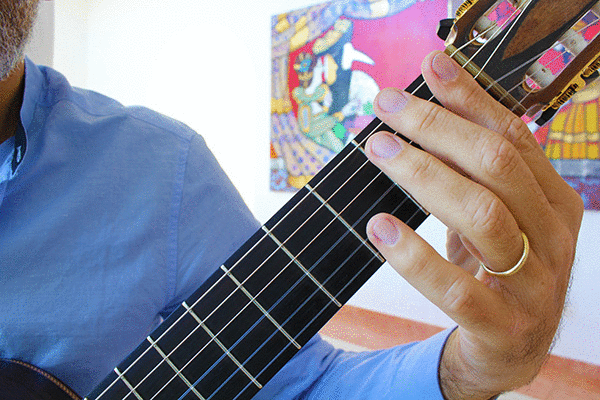
Baja la Ceja. Luego baja el dedo 2 y finalmente bajas el dedo 4. Debes aprender a bajar los dedos sobre el diapasón en la medida que son necesitados.
___________________________________________
Put barre 1 down first. Following the bar finger, finger 2 goes down to stop the the A and finally the D is stopped by finger 4. The guitar player must master the technique of lowering the fingers on the fingerboard only when they are needed so as to be able to change positions in time and not mount up unnecessary tension in the Left hand.
Como Usar Una “Leva”; HOW TO USE LEVERS
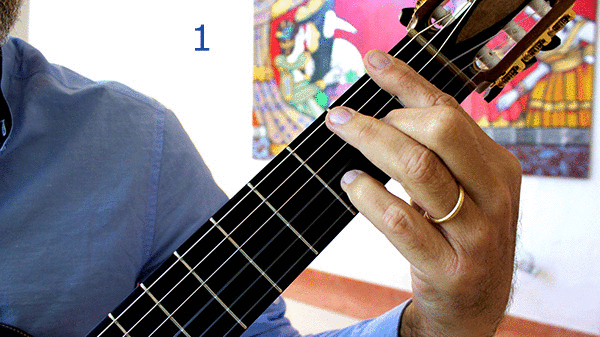
El LA en la 3a y el RE en la 2a cuerda son usados como levas. Lleva a estos dedos el peso de la mano y el trabajo de la mano izquierda se verá facilitado enormemente.
______________________________________________
The A on string 3 and the D on string 2 are used to act as levers upon which the weight is shifted in order to lift the fingers off the fingerboard with greater ease.
Video 10
Pentagrama y Video Staff & Video 11
Cambio de Presentación; CHANGE OF PRESENTATION
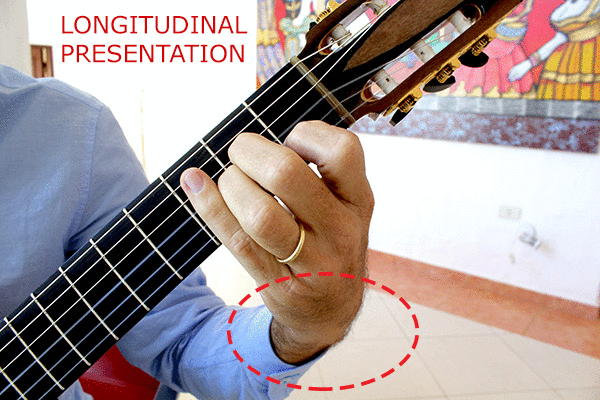
ANIM. 1
Luego de repetir la primera parte de Recuerdos, la mano cambia de una presentación longitudinal a una transversal.
________________________________________________
ANIM. 1
After repeating the first part of Recuerdos, the hand changes from a longitudinal to a transversal presentation (The hand passes from an A Minor to an A Major chord).
SLIDE AND ROTATE
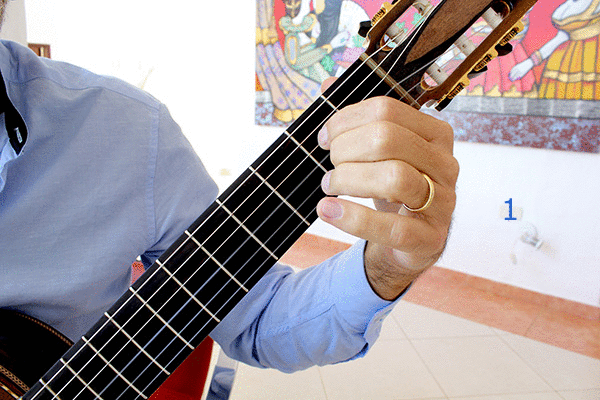
ANIM. 2
Al comenzar la segunda parte, se nos presenta un cambio de presentación. El dedo 2 actuará como el pivot alrededor del cual girará la mano izquierda.
_____________________________________________
ANIM. 2
When part 2 begins, there is a change of presentation once again. Finger 2 slides from the C# to the D. Finger 2 is the pivot around which the hand rotates for the change in presentation.
Video 11
Pentagrama y Video Staff & Video 12
Cambio de Presentación; CHANGE LEFT HAND PRESENTATION
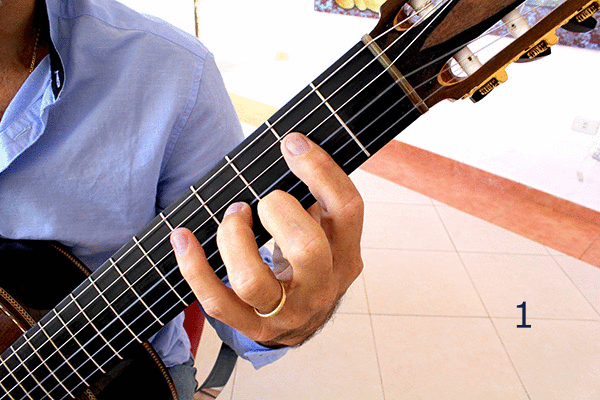
En este cambio de presentación deberás hacer lo opuesto de lo que hiciste en la animación 2 del pentagrama anterior. Pasas de una Presentación longitudinal a una transversal. Tárrega cambia de tonalidad y se queda en el LA mayor un rato para que el oído se estabilice.
______________________________________________
This left hand rotation is exactly the opposite of the rotation from animation 2 in the previous staff. It goes from a Longitudinal to a Transversal Presentation. The Left Hand goes form the bar chord to an the A Major chord. Tárrega wants to reinforce the harmonic change to A Major by playing around it for a few staffs.
Video 12
Pentagrama y Video/Staff & Video 13
En el segundo compás, Recuerdos va creando un crescendo para llegar ala parte más sublime de la obra. Deberás cambiar de una presentació longitudinal a una transversal. __________________________________________________________________________ In measure 2, Recuerdos builds up for the most emotive part of the work. The technique highlight is that you observe how the presentation of the hand is changed from a longitudinal to a transversal one. Read more about Left hand presentations here. In the video to the right I explain and illustrate the concept of presentation in depth.
El codo toca el costado: THE ELBOW TOUCHES THE SIDE
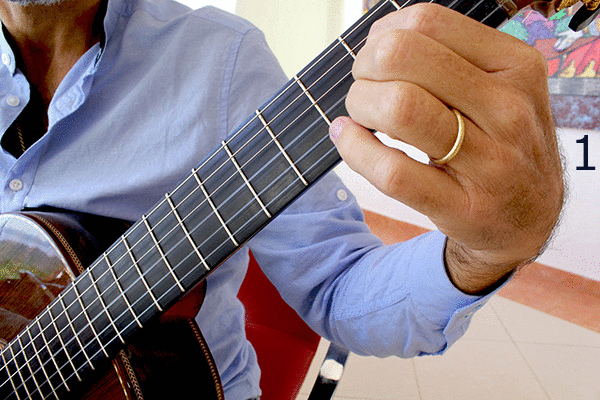
Al pasar del MI al FA#, los dedos de la mano izquierda se levantan del diapasón y cambias de posición acercando el codo al costado de tu cuerpo.
________________________________________________
Passing from the E to the F#, the left hand fingers are lifted from the fingerboard, while the position changes by getting the elbow closer to the side of the body until it comes in contact with the side.
Video 13
Pentagrama y Video 14/Staff & Video 14
Pon tus ojos en el traste al cual viajarás. El desplazamiento al nuevo traste debe realizarse con rapidez. Esta es la parte cumbre de la obra. El efecto sobre el público es fantástico. Usa el LA al aire para cubrir tu desplazamiento. __________________________________________________________________________ Put your eyes on the target fret. Both displacements of the arm have to be made very fast. This is the most moving part of the piece. The effect on the audience is fantastic. Play the open string A to create the cover and use it to move swiftly to the new position (see video)
 Back to Top
Back to Top
